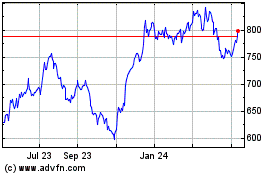NYSE on Track to Lose More ETF Listings
August 03 2017 - 5:59AM
Dow Jones News
By Asjylyn Loder and Alexander Osipovich
The New York Stock Exchange, long the dominant listing venue for
U.S. exchange-traded funds, is on track to lose ETF listings for a
second straight year as competing exchanges vie for a larger slice
of the fast-growing industry.
This week, 50 ETFs from BlackRock Inc.'s iShares lineup left
NYSE's Arca trading platform for the competition. Nasdaq Inc.
picked up 20 of the listings worth $124 billion, and Bats took the
remaining 30 worth $116 billion. The defections include the $33.1
billion iShares Core MSCI EAFE ETF and the $13.5 billion iShares
Edge MSCI Min Vol USA ETF.
BlackRock's moves, announced in late June, are part of the
firm's efforts to diversify its listings venues.
BlackRock and other issuers began to spread their ETFs across
multiple platforms following two high-profile market failures two
years ago, including an hourslong New York Stock Exchange outage in
July 2015 and, the next month, a series of trading halts that
caused ETFs to veer from the value of their underlying assets.
So far this year, one of the BlackRock's nine new listings have
gone to NYSE Arca, which remains the home for 209 of 343 of
BlackRock's U.S.-listed ETFs.
The industry's move to spread out their ETF listings was bound
to cut into NYSE Arca's business because it remains the largest ETF
exchange. After this week's switch-overs, Bats, part of CBOE
Holdings Inc., has 221 ETF listings, and Nasdaq has 373.
NYSE Arca listed 1,518 ETFs as of June, according to company
records. NYSE's ETF listings peaked at 1,574 in December 2015 but
fell to 1,510 at the end of last year. An NYSE spokeswoman said
Wednesday that they have 1,504 ETF listings.
The primary value of ETFs is trading revenue, not listings fees.
Bats has made substantial inroads in ETF volumes in recent years
and is frequently the market leader, with NYSE not far behind and
sometimes taking the top spot.
While ETFs can be bought and sold on any exchange during the
day, trading reverts to the listing exchange at the beginning and
ending of the trading day. Those few seconds, known as auctions,
are some of the busiest and most profitable for exchanges, with
trading fees paid by both buyers and sellers, and fewer
rebates.
As the largest listing exchange for company stocks and ETFs,
NYSE has an outsize advantage in auction trading, an advantage Bats
is trying to cut into. Bats has asked the U.S. Securities and
Exchange Commission for permission to create a cheaper alternative
to the end-of-day auctions that could draw trading away from the
listing exchange.
Both NYSE and Nasdaq have urged the SEC to reject Bats's
proposal. The SEC has until Aug. 20 to approve the plan, reject it
or open deliberations that could last for months.
Write to Asjylyn Loder at asjylyn.loder@wsj.com and Alexander
Osipovich at alexander.osipovich@dowjones.com
(END) Dow Jones Newswires
August 03, 2017 05:44 ET (09:44 GMT)
Copyright (c) 2017 Dow Jones & Company, Inc.
BlackRock (NYSE:BLK)
Historical Stock Chart
From Mar 2024 to Apr 2024

BlackRock (NYSE:BLK)
Historical Stock Chart
From Apr 2023 to Apr 2024
